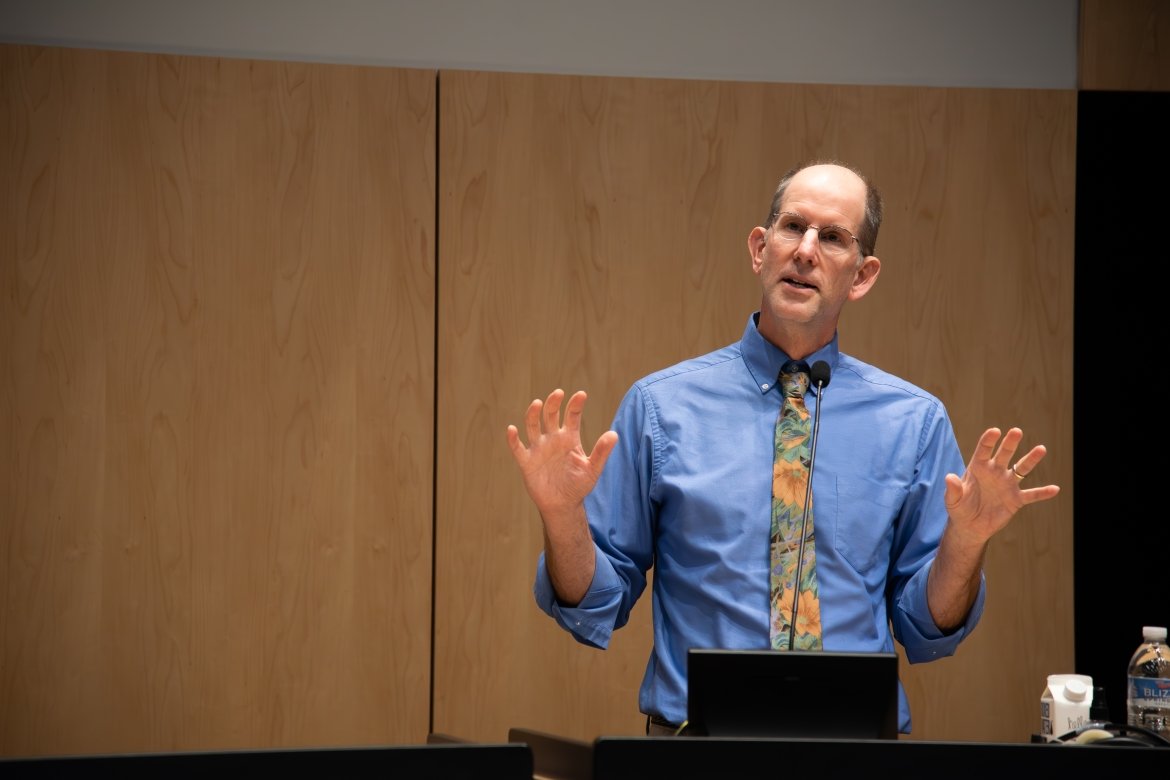Exploring what it means to be a restorative campus

David Karp, director of the Center for Restorative Justice in the School of Leadership and Education Sciences at the University of San Diego, was welcomed to ÎçŇążě˛Ą as the keynote speaker for the eighth annual BOOM! Learning Symposium.
In May 2020, the College had planned on hosting a speaker who would present a communal approach to prevent and respond to harm. The speaker, , a professor of leadership and the director of the Center for Restorative Justice in the School of Leadership and Education Sciences at the University of San Diego, was also slated to facilitate some training sessions. However, that plan was canceled as a result of the COVID-19 pandemic.
Though the audience has changed in the past four years, Lucas Wilson said that the need for ÎçŇążě˛Ą to reimagine its social justice work and learn to live more restoratively remains.
On April 15, Wilson, professor of Economics and Critical Race and Political Economy on the Ford Foundation, introduced Karp as the keynote speaker for the eighth annual Building on our Momentum (BOOM!) Learning Symposium. Other events taking place during this year’s BOOM! were a healing with Aaron Athey, a with Angie Patterson, and a virtual session led by President and Professor of Politics Danielle Holley on her spring 2024 course about the Supreme Court.
As part of his lecture, titled “,” Karp discussed restorative justice and what it means to build a restorative campus.
“We suspect that the old groups and ways are dying, and new ways are struggling to emerge. … Restorative justice building and community-based peacebuilding are going to play an important role in delivering us to whatever comes next,” said Wilson. “But for us, in order to get in there, our work begins right here, at ÎçŇążě˛Ą.”
What is restorative justice?
Restorative justice is a communal approach to prevent or respond to harm in a community with an emphasis on healing, social support and active accountability. Karp explained that restorative justice includes a variety of practices with many rooted in Indigenous and religious traditions. Some practices help prevent harm by helping people build relationships and strengthen communities. Others respond to harm by helping clearly identify harms, needs and solutions through an inclusive and collaborative decision-making process.
As an example, Karp recalled an experience from his time teaching a criminal justice class at Skidmore College. As the class was gathering one morning and engaging in small talk, he learned that one student hadn’t slept after a “miserable” weekend. Apparently, the student, who lived off-campus, had encountered a strange man standing outside her living room window, staring at her and her roommates before disappearing. The following night, when she was alone and getting ready for bed, she heard someone come in the front door. When she opened her bedroom door, she found the same stranger who had been outside her window the night before. She quickly shut the door and held the knob, bracing for what might happen next.
“The guy walked around for a few minutes but didn’t steal anything and eventually left. The student, however, did not sleep as she was pretty freaked out by what had happened,” said Karp.
When her roommates returned, she told the story about what had happened, and they were all too afraid to stay in their room.
Karp said he took the story as an opportunity to discuss what could be done and proposed applying restorative justice to the scenario.
Initially, students were stumped over the proposal because restorative justice involves a person taking responsibility in some way. However, in this particular case, they were unaware who the individual was. In detailing some restorative justice questions typically asked of the person who had been harmed, Karp asked the students to identify who had been harmed, what the impact was and what the impacted party needed. The impacted student immediately started sharing. She noted that the man was able to walk into the house so easily because the front door lock was broken and the landlord did not fix it, even after the concern had been brought up.
In response, one student in the class said they knew how to fix locks and offered to join the impacted party on a trip to Home Depot and install a new lock. While grateful for the offer, the impacted student further asserted that she and her roommates were actually looking to get out of the lease to their rental but were uncertain about the process. Another student chimed in, saying that their mother was a lawyer, and they would be happy to call to figure out the next steps. After that, another student said they weren’t comfortable with any of the roommates being alone at this dwelling. As a result, the class collectively made a schedule with shifts, so that none of the roommates had to be alone after 8 pm.
“That whole discussion didn’t take much longer than it took for me to describe it to you,” said Karp. “It was just a couple minutes of brainstorming, and in those few minutes, I saw the student completely change from looking so miserable, so exhausted and so hopeless to just exhaling and relaxing. She had ideas, a plan and support. That’s how restorative justice works.”